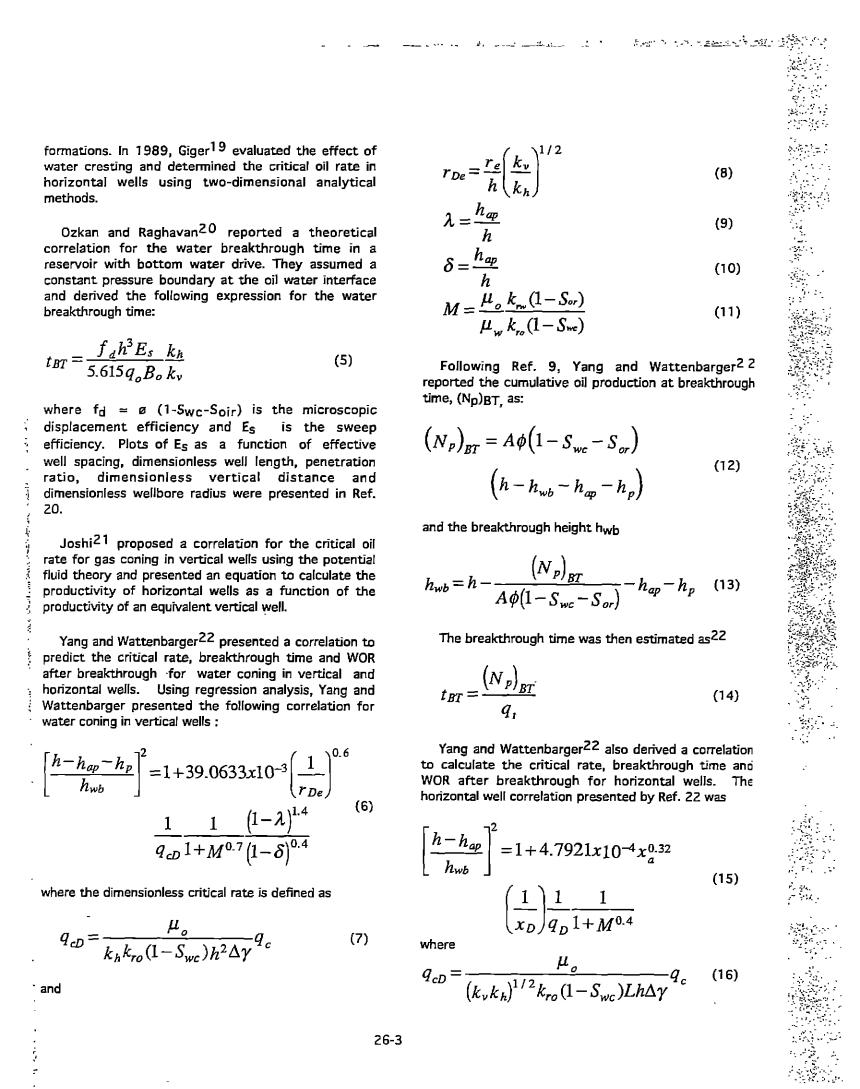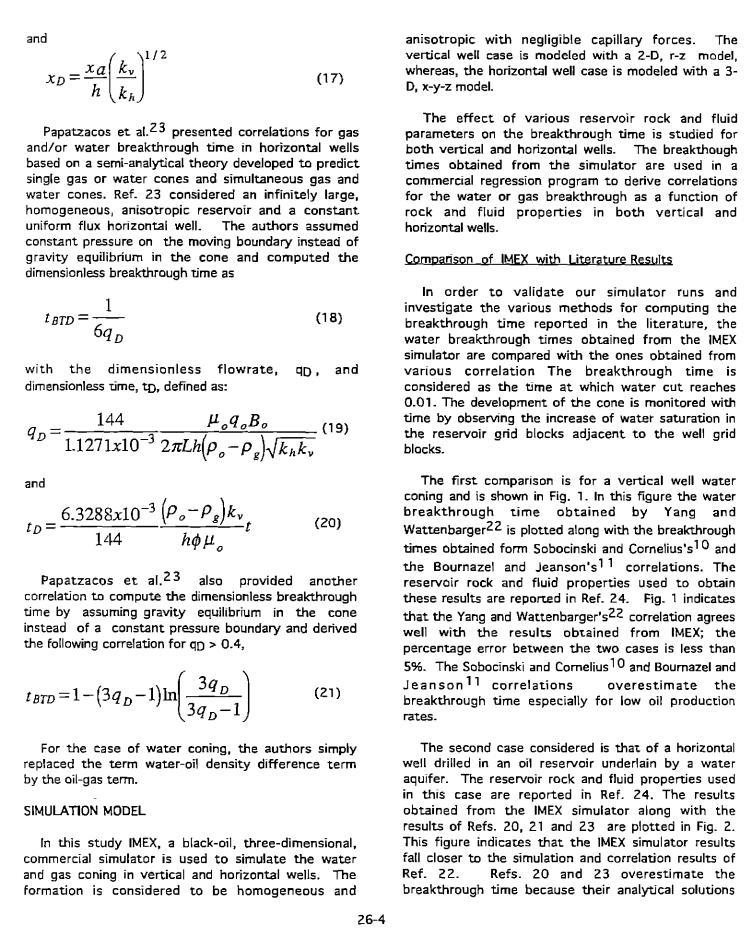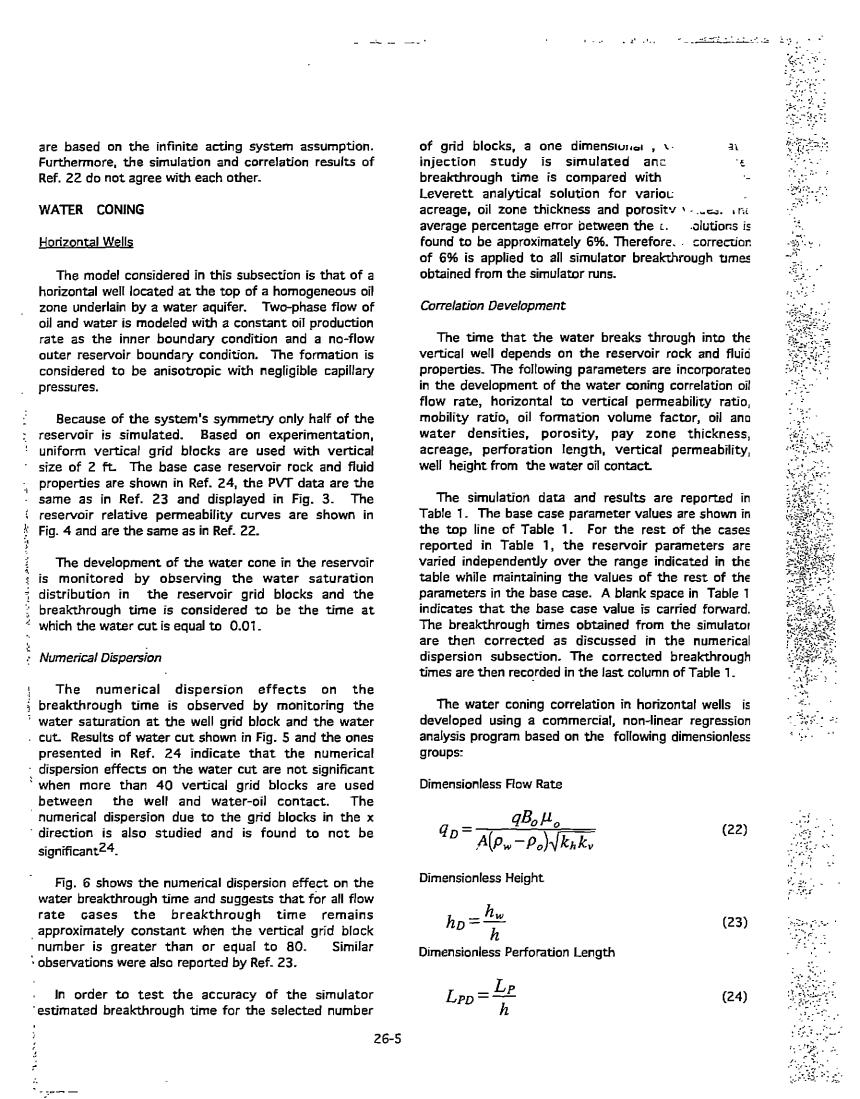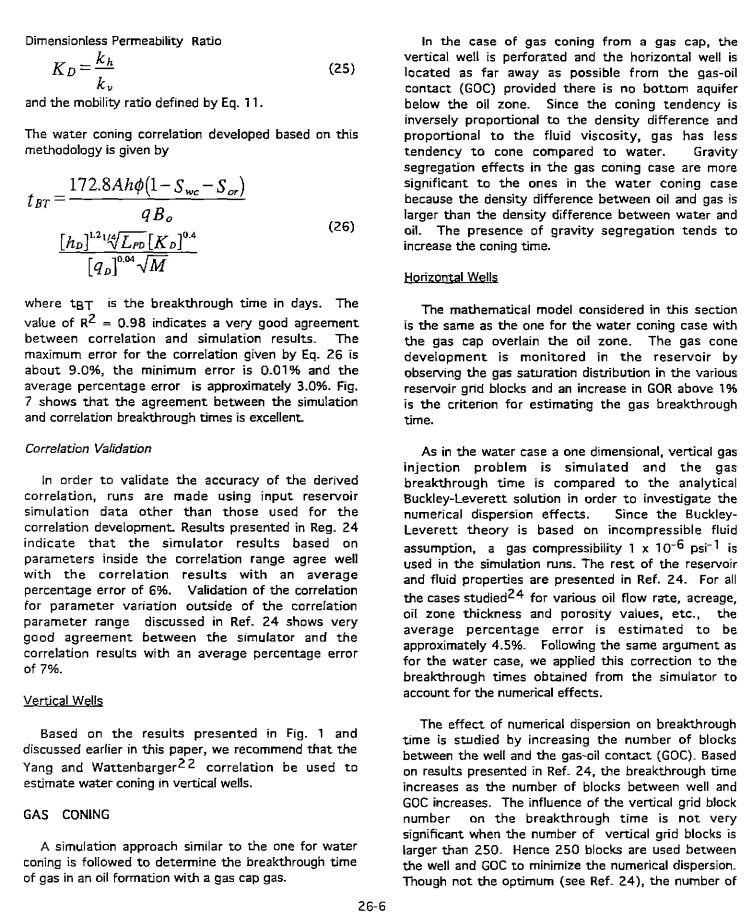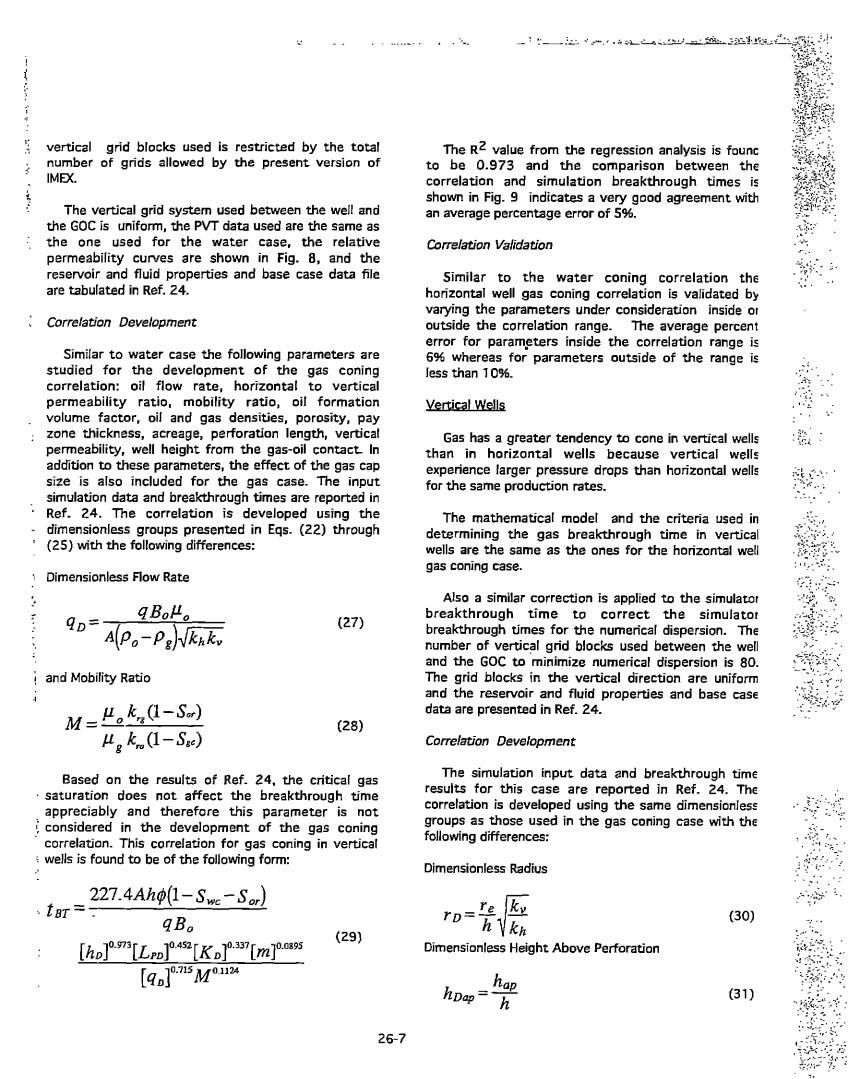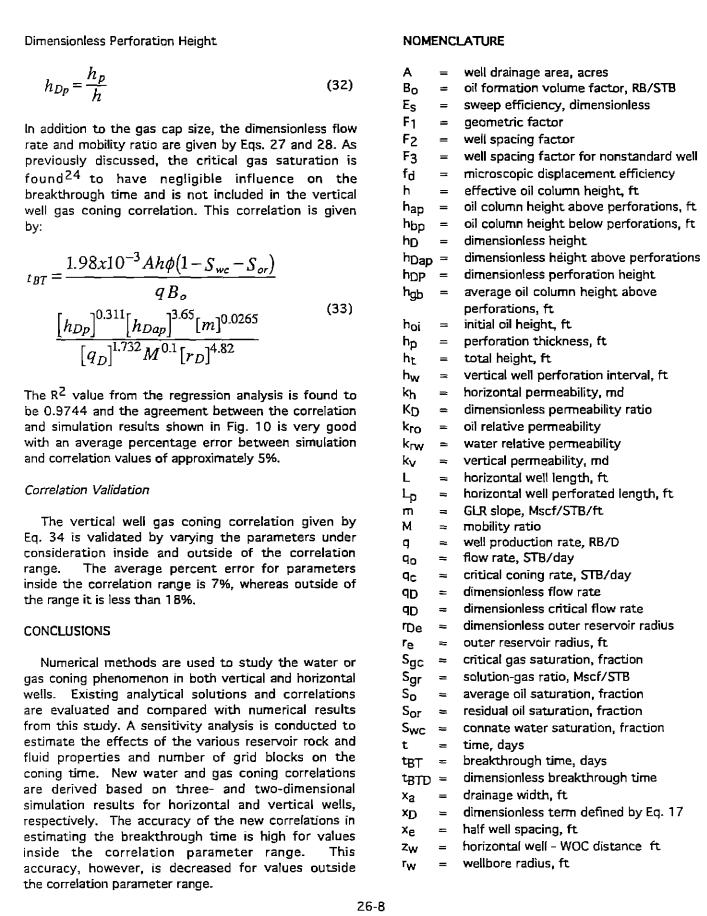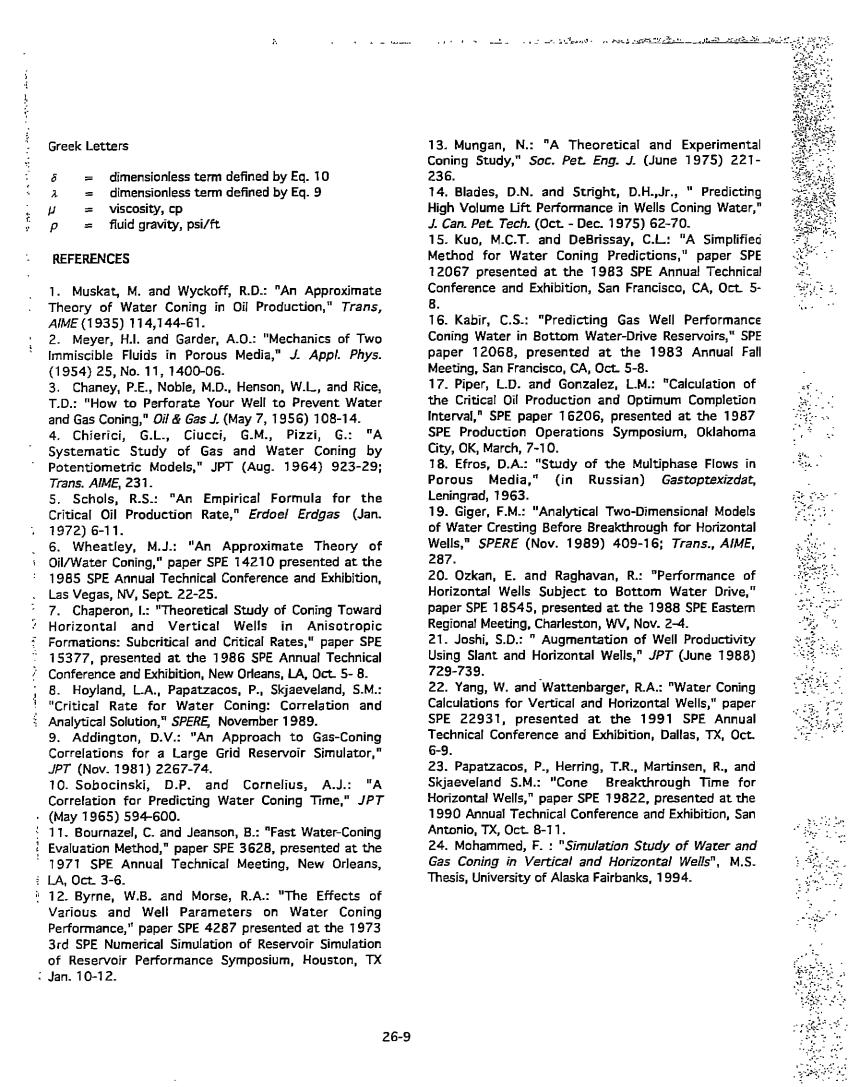
water-gas-coning
.pdfWATER AND GAS CONING IN HORIZONTAL AND VERTICAL
WELLS
D.G. HATZIGNATIOU F. MOHAMED
this article begins on the next page F
. '- ,'. ,- |
. ",: .J_ n- _-..:....._~~'-_...;...$~~~ :~ , !: A" .l.d:~1 -':r:.~ |
:.:....:......: ;;.r;~+:-;..,..3..~i..~~:.~ .:;\~._.. |
:,. |
|
|
|
|
,."- '.- |
|
PETROLEUM SOCIETY OF CIM & AOSTRA |
PAPER NO. 94-26~ |
j . ','::'';-.,;- |
||
-:~.?~.... |
:. |
|||
- .-.
Water and Gas Coning in Horizontal and
Vertical Wells
:,'.:
., -' -
D.G. Hatzignatiou
F. Mohamed
University of Alaska
|
This paper is to be presented at the 45th annual technical meeling of Ihe Petroleum Society of elM organized by the Petroleum Society of CIM, |
|
.", |
co-sponsored by AOSTRA in Calgary, Canada, June 12-15, 1994. Discussion of Ihis paper is invited and may be presented at the meeting if filed |
|
In writing with the technical program chairman prior to Ihe conclusion of the meeting. This paper and any discussion filed will be considered for |
||
'" |
||
pubricalion in elM journals. Publication rights are reserved. This is a pre-print and is subject to correction. |
||
:; |
ABSTRACT
In this paper the coning of water or gas in vertical and horizon tal wells is examined. The existing analytical solutions and correlations do nat predict accurately the water breakthrough for horizontal wells; also solutions or correlations for predicting the gas breakthrough time do not exist. A three-dimensional, three-phase, blackoil, commercial simulator is used to examine the effects of various rack and fluid properties, well configurations, reservoir anisotropy, etc. on the breakthrough time and to .: " . ,'e correlations which can be used to predict the time at which gas or water cones into a vertical or horizontal well, A correction is applied to the simulator
,breakthrough times |
to incorporate the effects of |
: numerical dispersion. |
The results obtained from the |
. newly derived correlations are compared with existing ,analytical and numerical solutions for a number of cases; these comparisons indicate that the correlations developed in this work can be used to predict the water or gas breakthrough time in vertical and horizontal wells quite accurately.
INTRODUCTION
Water and/or gas coning is a serious problem in many reservoirs with wells producing from an 011 zone underlying a gas cap, overlying an aquifer or both, Coning occurs in a well on production, when the water or gas zone moves up towards the wellbore in the form of a cone.
Eventually, the water or gas breaks through intc the well and water from the aquifer and/or gas from the gas cap is produced along with oil. The water or gas production increases progressively after breakthough time and may reduce significantly the crude oil production.
The main factors affecting the water and/or gas coning tendency are the density difference between oil and gas or oil and water, the viscosity of water or gas, formation permeability, pressure drawdown, flow rate, etc. More specifically, the tendency of • fluid to cone is directly proportional to the densit~ difference between the fluid and crUde oil, but
" "
~~f~~;
:A_t~>t
: ..-:.- .
-..':
, "
li~~~.\~.~~
.,- ..
•:~-;"'i'- r~," -
..~;t>_·~'"
..""'j
- .'....; '_ .
•·t· ~ _
::;.,-
, "
:...--';
,··:-i~·
,,-.;.
:, ~" .
... .,:~f.
, '., -.·r·····
inversely proportional to the fluid viscosity and reservoir permeability.
The water and/or gas coning can be reduced by (i) decreasing the well production rate; (ii) improving the productivity of the well; (iii) using horizontal instead of vertical wells to produce the formation; (iv) selectively partially penetrating the well at the top of the reservoir in the case of water coning, at the bottom of the reservoir in the case of gas coning, and close to the center of the pay zone in the case of simultaneous water and gas coning; (v) recompleting the well at a different elevation t.o increase the distance between the gas-oil or water-oil contact and the perforated interval; and (vi) infill drilling.
Most of the research efforts in the area of water and gas coning have concentrated on estimating the critical oil rate and the post breakthrough well behavior. In ti,e subsequent parts of this section some of these studies will be discussed for both vertical and horizontal wells.
Vertical Wells
One of the first papers published on the coning phen~mena was by Muskat and Wyckoff 1. They solved
Laplace's equation for single phase, steady-state, incompressible flow and presented an approximate solution of the critical flow rate in isotropic formations. The analytical solution of Ref.1 was simplified by Meyer and Garder2 for radialflow, whereas Chaney et al. 3 and Chierici et al.4 used potentiometric models to obtain the critical flow rate. Ref. 4 studied the effect of reservoir geometrY and well configurations on critical coning rate and optimum perforation interval for simultaneous gas and water
coning. Schols5 developed an empirical expression for the critical rate from experiments conducted on HeleShaw models.
An approximate theory for the critical oil rate in anisotropic formations was presented by considering
the oil-water |
interface to |
be |
a |
streamline 6 . |
|
Similarly, |
Chaperon 7 presented a |
solution for the |
|||
critical |
rate |
of vertical |
wells |
in |
anisotropic |
formations in a closed system and reported that when the vertical permeability decreases, critical rate increases slightly, but the elevation of the critical cone does not change appreciably.
Two methods, one analytical and one numerical, were presented by Hoyland et al.8 t.o predict the critica[ rate for water coning in anisotropic,
26-2
homogeneous formations. The analytical solution was based on 'the assumption of an infinitely conductive wellbore and the results of Ref. 8 were presented in a graphical form of dimensionless critical rate, qeD, versus dimensionless radius, rD, as a function of the fractional well penetration for both isotropic and anisotropic fOmlations.
Addingt.on 9 developed generalized correlations for the critical coning rate and the gas-liquid ratio (GLR) after gas breakthrough using a three-dimensional simulation study of the Prudhoe Bay field. The author showed that his correlations can also be applied in heterogeneous reservoirs by using an average formation permeability. Ref. 9 computed the average
oil column height above the perforations, |
hgb'as |
|
(1 ) |
and the GLR after gas breakthrough as |
|
1og(GLR) = m(hap - hgb) +1og(S g.) |
(2) |
where |
|
h- Soh,-hoiSo. |
(3) |
1- S'" -Sgc-So• |
|
and |
|
|
(4) |
A correlation for predicting the water cone rise from static conditions until breakthrough was also developed by Sobocinski and Cornelius 1 0 for a homogeneous, incompressible system with no gas cap, producing at a constant rate. Cone breakthrough time and critical rate can be determined from dimensionless correlating groups reported by Ref. 10. Bournazel and Jeanson11 conducted laboratory experiments and reported a correlation for the water breakthrough time in vertical wells similar to the correlation of Ref. 10. Finally, Refs. 12-17 also presented results on wat.er or gas coning for vertical wells based on laboratory or simulation studies.
Horizontal Wells |
|
|
|
Efros 1 8 was |
the |
first to study gas |
coning and |
report a correlation |
for critical rate in horizontal |
||
wells whereas, |
Chaperon7 presented a |
solution for |
|
critical rate for horizontal wells in anisotropic
